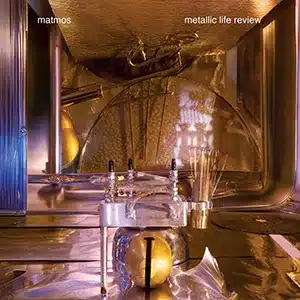
Matmos construct complex, layered soundscapes that are so unique, they inspire creativity rather than imitation. Most importantly, though, their music is emotive.
 Metallic Life Review Matmos Thrill Jockey 20 June 2025
Metallic Life Review Matmos Thrill Jockey 20 June 2025
Matmos have built their decades-long career by making electronic records using constraints and conceptual frameworks. They’ve recorded an album with only sounds made by objects in their apartment. They’ve recorded a record of the sounds of operating room procedures. They’ve recorded an LP by elaborately editing the music of late Polish composer Bogusław Schaeffer. They’ve recorded an album of “sound portraits” of influential LGBTQ figures throughout history. They even shirked microphones altogether for a record of pure synthesizer experiments, having decided their usual methods for making such profoundly unusual music were worth abandoning for the sake of artistic constraint.
The impressive thing about Matmos is that the gimmicks don’t define them. They construct complex, layered soundscapes that are so unique, they inspire creativity rather than imitation. Most importantly, though, their music is emotive. It triggers feelings. The emotional reaction precedes and overwhelms the intellectual response. Listening to Matmos is not an academic endeavor. It’s a visceral experience. That is also true for their latest album, Metallic Life Review, which was constructed entirely from sounds made with metallic objects.

The opener, “Norway Doorway”, begins with the crash of a gong, followed by silence, and then another louder crash accompanied by a piercing squeal. The squeal is chill-inducing, the stuff of horror films, but its source is puzzling. A survey of the liner notes introduces several possibilities: fence post connectors, scissors, a spaghetti bowl, and an afro rake. Could it be the cheese grater? Or maybe the “door recorded in a hallway at Blå in Oslo, Norway”. Each object is listed beside the name of its “player”, sometimes alongside a traditional instrument or a step in the production process, such as ride cymbal, aluminum tubular bells, sampling, or sequencing.
Matmos are candid about how they make their records. One could say the unique process used to build each album is inseparable from the way the listener consumes it. The most extreme example is their 2001 effort, A Chance to Cut Is a Chance to Cure, which on the surface is often playful and upbeat, but undergoes a dramatic shift in tone when the listener peeks at the liner notes and discovers some of its sound sources: “plucked and bowed rat cage”, “teeth”, “skin”, “human skull”.
For decades, Matmos have created art that raises fascinating questions about a relatively modern phenomenon in the history of recorded music: the dissociation between the sounds we hear and the way these sounds are created. Given a detailed list of metal objects used to compose a track like “Norway Doorway” (which is even named after one of the objects), the listener remains baffled by the sounds that rattle, scrape, whine, and slide through their headphones.
To go one step further, how does one begin to identify how the sounds have been tweaked and mangled by samplers? A listener can study the spaghetti bowl in their kitchen for hours and still struggle to comprehend exactly where and how this piece of dinnerware was played amongst the percussive turmoil of “Norway Doorway”.
Despite their penchant for abstraction, Matmos create fairly accessible music. The clatter and dissonance of “The Rust Belt” is grounded by the steady thump that fills the role of the bass drum, though the listener understands it is likely “pots and pans” or perhaps someone rapping on a railing. The sounds are skewed, but the blueprint is familiar.
“The Chrome Reflects Our Image” resembles a toddler’s wind-up music box backed by guitar plucking. A string section, apparently made with the sounds of a frying pan, is introduced about halfway through, turning the track into a slightly off-kilter waltz. “Steel Tongues” gorgeously melds a steel tongue drum, glockenspiel, and a “sampled pulse box xylophone” to form a plinking cascade of melody. The song offsets the sinister mood of the first two tracks, a paradisal respite.
Matmos place the longest and most abstract track last. Clocking in at over 20 minutes, “Metallic Life Review” is a meandering, often formless performance that resembles a John Cage score for percussion ensemble. It’s a constantly changing sonic adventure, moving from peculiar downtempo beats to ear-scuffing drone to frenetic IDM that sounds like something Aphex Twin might make if he could use only pocket change, tumbled stones, and an overburdened keychain. It’s the easiest track to play in the background while doing laundry or washing dishes. It’s also one of the most rewarding listens, offering plenty of pleasing sonic goodies for those who choose to listen attentively.
Of course, the same could be said for Metallic Life Review as a whole. Matmos fans should adore this record, but it likely won’t win over those who don’t already make a habit of listening to unorthodox sonic collage that blurs the arbitrary line between music and sound sculpture. If anyone could, though, it’s Matmos, and the proof is here. If you were to play “Changing States” for even your most closed-minded friend, forcing them to listen through that intoxicating final buildup, you’re guaranteed to achieve some emotional response.
On paper, Matmos make music so conceptually novel you could convince yourself it’s an academic exercise. If you take the time to listen, you’ll find their music is alive, a human endeavor crafted with care, all to make you feel something.


